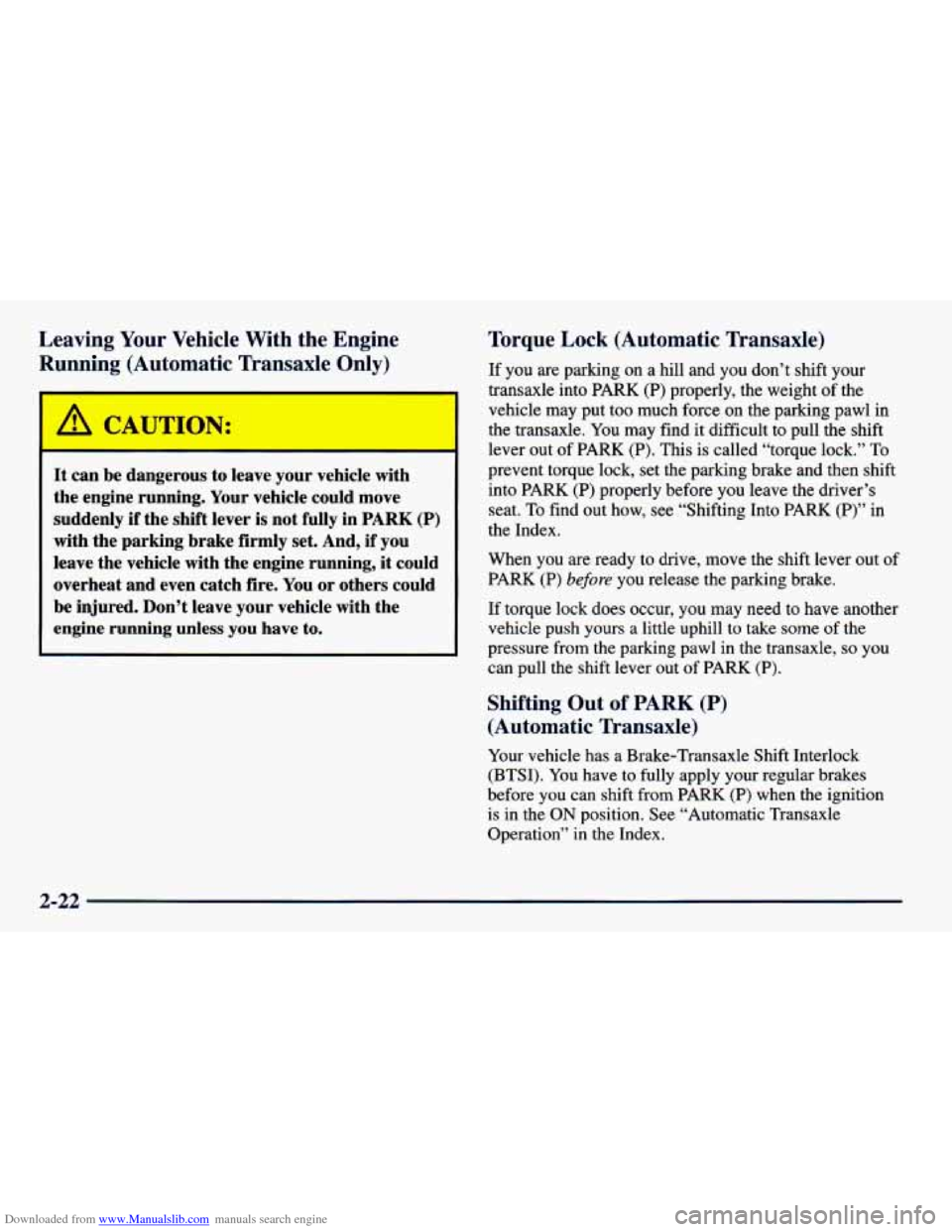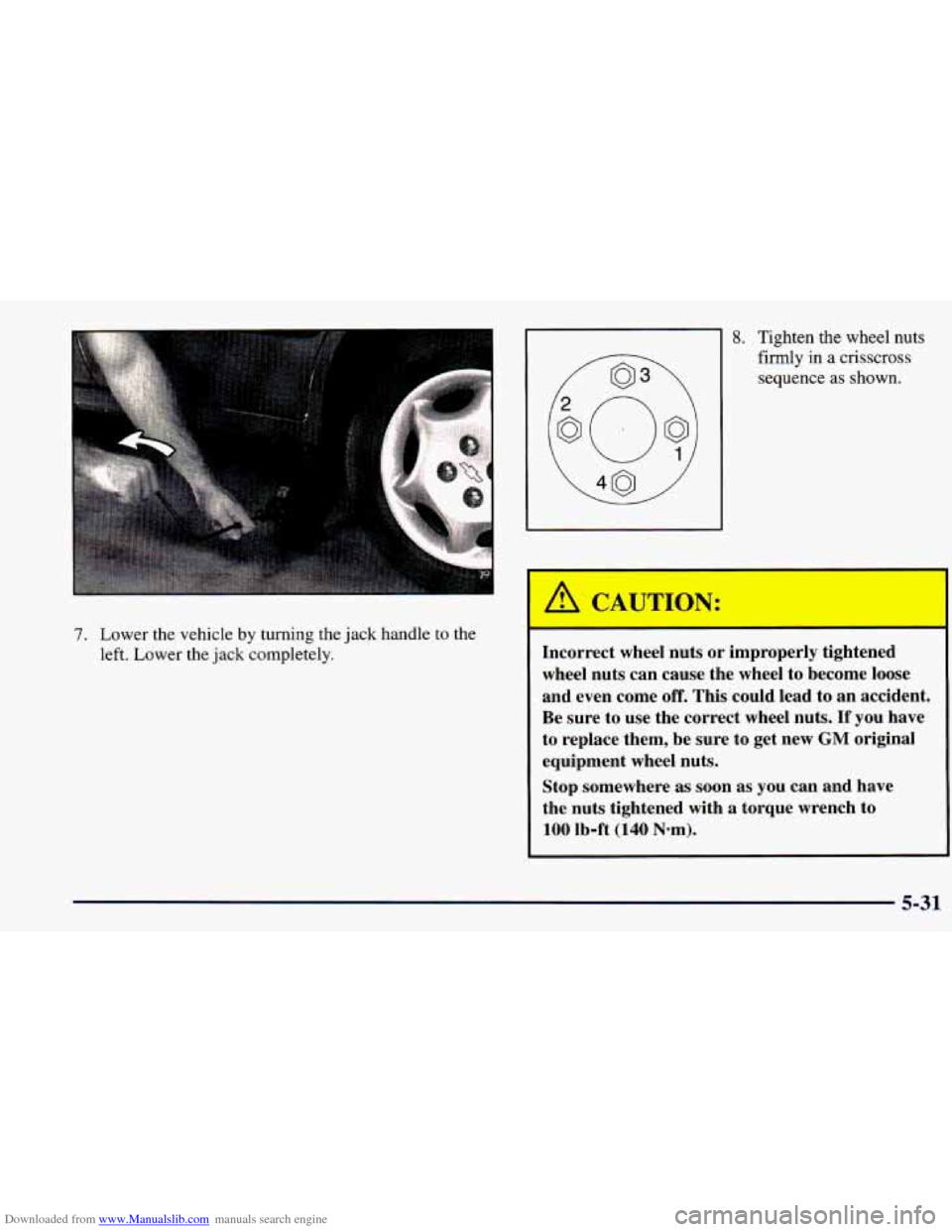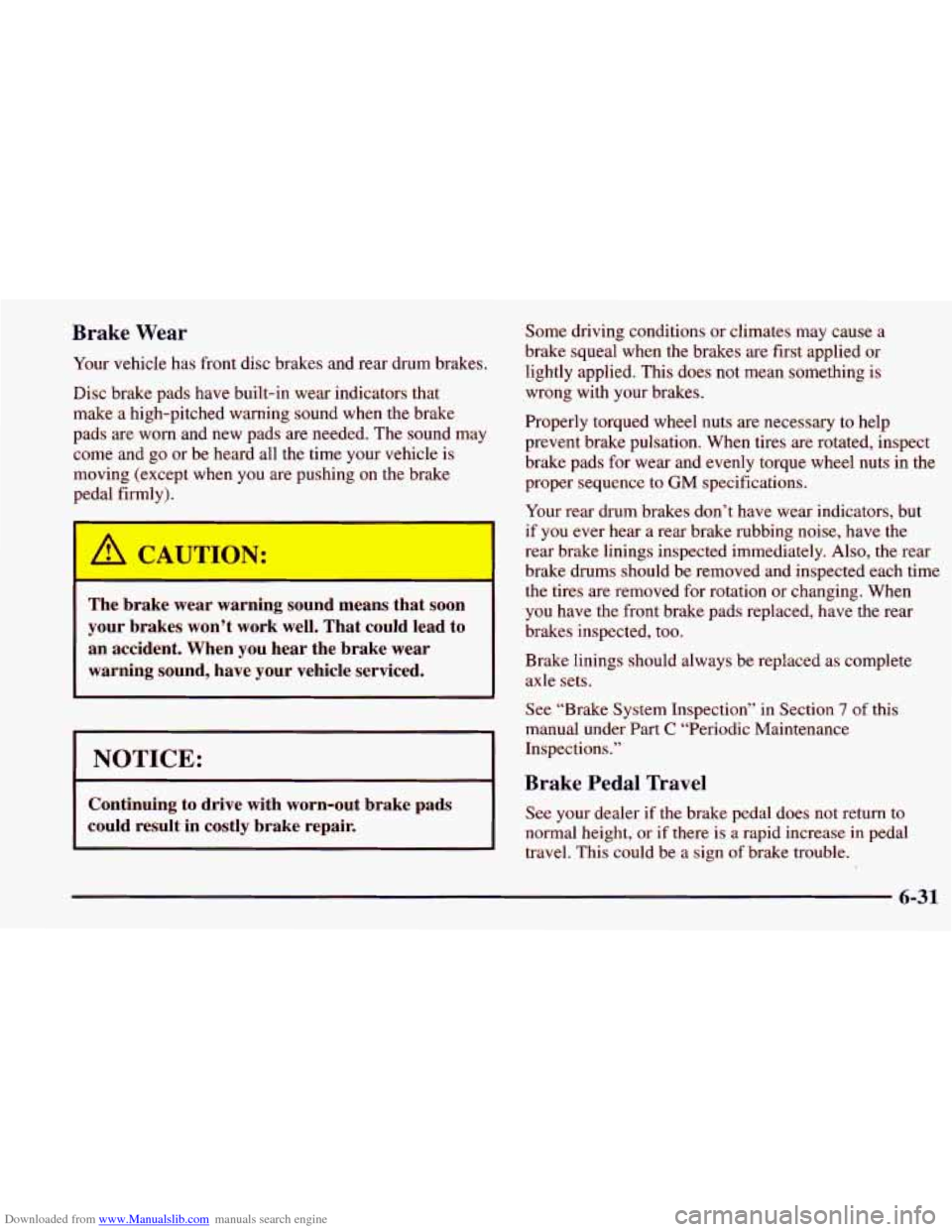1998 CHEVROLET PRIZM torque
[x] Cancel search: torquePage 100 of 364

Downloaded from www.Manualslib.com manuals search engine Leaving Your Vehicle With the Engine
RI - - ng (Autom;- ‘ic -‘an - - --’e Only)
It can be dangerous to leave your vehicle with
the engine running. Your vehicle could move
suddenly if the shift lever is not fully in PARK
(P)
with the parking brake firmly set. And, if you
leave the vehicle with the engine running, it could
overheat and even catch fire. You or others could
be injured. Don’t leave your vehicle with the
engine running unless you have to.
Torque Lock (Automatic Transaxle)
If you are parking on a hill and you don’t shift your
transaxle into PARK (P) properly, the weight of the
vehicle may put too much force on the parking pawl in
the transaxle. You may find it difficult to pull the shift
lever out of PARK (P). This is called “torque lock.” To
prevent torque lock, set the parking brake and then shift
into PARK (P) properly before you leave the driver’s
seat. To find out how, see “Shifting Into PARK (P)” in
the Index.
When you are ready to drive, move the shift lever out of
PARK (P)
before you release the parking brake.
If torque lock does occur, you may need to have another
vehicle push yours a little uphill to take some of the
pressure from the parking pawl in the transaxle,
so you
can pull the shift lever out of PARK (P).
Shifting Out of PARK (P)
(Automatic Transaxle)
Your vehicle has a Brake-Transaxle Shift Interlock
(BTSI). You have to fully apply your regular brakes
before you can shift from PARK
(P) when the ignition
is in the
ON position. See “Automatic Transaxle
Operation” in the Index.
2-22
Page 221 of 364

Downloaded from www.Manualslib.com manuals search engine 7. Lower the vehicle by turning the jack handle to the
left. Lower the jack completely.
8. Tighten the wheel nuts
firmly
in a crisscross
sequence
as shown.
Incorrect wheel nuts or improperly tightened
wheel nuts can cause the wheel to become loose
and even come off. This could lead to
an accident.
Be sure to use the correct wheel nuts. If you have
to replace them, be sure to get new
GM original
equipment wheel nuts.
Stop somewhere
as soon as you can and have
the nuts tightened with
a torque wrench to
100 lb-ft (140 N-m).
5-31
Page 223 of 364

Downloaded from www.Manualslib.com manuals search engine NOTICE:
Improperly tightened wheel nuts can lead to
brake pulsation and
rotor damage. To avoid
expensive brake repairs, evenly tighten the wheel
nuts in the proper sequence and to the proper
torque specification.
Don’t try to put a wheel cover on your compact spare
tire.
It won’t fit. Store the wheel cover in the trunk
until you have the flat tire repaired or replaced.
I NOTICE:
Wheel covers won’t fit on your compact spare.
If you try to put a wheel cover on your compact
spare, you could damage the cover or the spare. Storing
a jack, a tire
or other equipment in the
passenger compartment
of the vehicle could
cause injury. In a sudden stop
or collision, loose
equipment could strike someone. Store all these
in the proper place.
5-33
Page 257 of 364

Downloaded from www.Manualslib.com manuals search engine Brake Wear
Your vehicle has front disc brakes and rear drum brakes.
Disc brake pads have built-in wear indicators that
make a high-pitched warning sound when the brake
pads are worn and new pads are needed. The sound may
come and
go or be heard all the time your vehicle is
moving (except when you are pushing on the brake pedal firmly).
The brake wear warning sound means that soon
your brakes won’t work well. That could lead to
an accident. When you hear the brake wear
warning sound, have your vehicle serviced.
I NOTICE:
I
Some driving conditions or climates may cause a
brake squeal when the brakes are first applied or
lightly applied. This does not mean something
is
wrong with your brakes.
Properly torqued wheel nuts are necessary to help
prevent brake pulsation. When tires are rotated, inspect
brake pads for wear and evenly torque wheel nuts in the
proper sequence to
GM specifications.
Your rear drum brakes don’t have wear indicators, but
if you ever hear a rear brake rubbing noise, have the
rear brake linings inspected immediately. Also, the rear
brake drums should be removed and inspected each time
the tires are removed for rotation or changing. When
you have the front brake pads replaced, have the rear
brakes inspected, too.
Brake linings should always be replaced as complete
axle sets.
Continuing to drive with worn-out brake pads
could result in costly brake repair.
See “Brake System Inspection” in Section 7 of this
manual under Part
C “Periodic Maintenance
Inspections.”
Brake Pedal Tra
See your dealer if the brake pedal does not return to
normal height, or if there is a rapid increase in pedal
travel. This could be a sign
of brake trouble.
Page 265 of 364

Downloaded from www.Manualslib.com manuals search engine Tire Inspection and Rotation
Tires should be rotated every 6,000 to 8,000 miles
(10 000 to 13 000 km). Any time you notice unusual
wear, rotate your tires as soon as possible and check
wheel alignment. Also check for damaged tires or
wheels. See “When It’s Time for New Tires” and
“Wheel Replacement” later in this section for
more information.
The purpose of regular rotation is to achieve more
uniform wear for all tires on the vehicle. The first
rotation is the most important. See “Scheduled
Maintenance Services” in the Index for scheduled
rotation intervals. Don’t include the compact spare tire
in your
tire rotation.
After the tires have been rotated, adjust the front
and rear inflation pressures as shown on the
Tire-Loading Information label. Make certain that
all wheel nuts are properly tightened. See “Wheel
Nut Torque” in the Index.
When rotating your tires, always
use the correct rotation
pattern shown here.
-
A CA u T1GI.C:
Rust or dirt on a wheel, or on the parts to which
it is fastened, can make wheel nuts become loose
after
a time. The wheel could come off and cause
an accident. When you change
a wheel, remove
any rust or dirt from places where the wheel
attaches to the vehicle. In an emergency, you can
use
a cloth or a paper towel to do this; but be
sure to use a scraper or wire brush later, if you
need to, to get all the rust or
dirt off. (See
“Changing
a Flat Tire” in the Index.)
I
6-39
Page 285 of 364

Downloaded from www.Manualslib.com manuals search engine Capacities and Specifications
Engine
Type .................................... L4
Compression Ratio ...................... 10.0: 1
Firing Order
.......................... 1-3-4-2
Fuel Delivery
........... Multi-Port Fuel Injection
Piston Displacement
.............. 109 CID (1.8L)
Valve Arrangement
........ Double Overhead Cam
Thermostat Temperature
........... 167°F (76°C)
Wheel Nuts
Wheel Nut Torque ........... 100 lb-ft (140 Nem)
Capacities (Approximate)
The following approximate capacities are given in
English and metric conversions.
Air Conditioning
.............. See the refrigerant
information label under the hood.
Automatic Transmission
3-Speed
.................. 2.6 quarts (2.5 L) **
4-Speed .................. 3.3 quarts (3.1 L) **
Differential (3-speed only) ...... 1.5 quarts (1.4 L)
Manual Transaxle ............ 2.0 quarts (1.9 L)**
Cooling System
Manual Transaxle
.......... 6.6 quarts (6.2 L)
Automatic Transaxle .......... 6.4 quarts (6.1 L)
Fuel Tank ................... 13.2 gallons (50 L)
Engine Oil (Change w/ Filter*)
... 3.9 quarts (3.7 L)
* When changing the oil filter, additional oil may
be needed. Recheck the oil level after filling. See “Engine Oil” in the Index.
** Recheck fluid level after filling. See “Automatic
Transaxle Fluid” or “Manual Transaxle Fluid”
in
the Index.
6-59
Page 357 of 364

Downloaded from www.Manualslib.com manuals search engine Skidding ...................................... 4-14
Sound Equipment. Adding
.............. 2.14.3.15. 6.53
Spare Tire. Compact
............................. 5-33
Specifications and Capacities
...................... 6-59
Specifications. Engine
........................... 6-59
Speech Impaired. Customer Assistance
............... 8-4
Speedometer
................................... 2-44
Stains. Cleaning
................................ 6-46
Starter Switch Check
............................ 7-39
Starting Your Engine
............................ 2- 13
Steam
........................................ 5-14
Steering
...................................... 4-10
In Emergencies
............................... 4- 11
Power
...................................... 4-10
Storage Compartments
........................... 2-37
Storage. Vehicle
................................ 6-32
Stuck: In Sand. Mud. Ice or Snow
.................. 5-34
Sun Visors
.................................... 2-38
Sunroof
....................................... 2-39
Symbols. Vehicle
................................ vm
Tips
........................................ 4-10
...
Tachometer .................................. 2-44
Tape Player Care
............................... 3- 15
Temperature Display
............................ 2-44
Theft
......................................... 2-10
Thermostat
.................................... 6- 25
Third Gear. Manual Transaxle
..................... 2- 18
Tilt Column
................................... 2-26
Time. Setting the
................................ 3-6
Tire Chains
.................................... 6-44
TireLoading
................................... 4-28 Tire-Loading Information Label
................... 4-28
Tires
......................................... 6-37
Alignment and Balance
........................ 6-42
Buying New
................................. 6-40
Chains
...................................... 6-44
Changing a Flat
.............................. 5-23
Cleaning
.................................... 6-50
Compact Spare
............................... 5-33
Inflation
.................................... 6-38
Inflation Check
............................... 7-37
Inspection and Rotation
........................ 6-39
Pressure
.................................... 6-38
Temperature
................................. 6-42
Traction
.................................... 6-41
Treadwear
................................... 6-41
Uniform Quality Grading
....................... 6-41
Wear Indicators
.............................. 6-40
Wheel Replacement
........................... 6-42
When It’s Time for New
....................... 6-40
TorqueLock
................................... 2-22
Torque, Wheel Nut ......................... 5-31, 6-59
Towing a Trailer
................................ 4-30
Towing Your Vehicle
............................. 5-8
Trailer Backingup
................................. 4-35
Brakes
..................................... 4-34
Driving on Grades
............................ 4-36
Driving with
................................. 4-34
Following Distance
........................... 4-35
Hitches
..................................... 4-33
Maintenance When Towing
..................... 4-37
Loading
.................................... 4-28
TopStrap
..................................... 1-53
9-9
Page 358 of 364

Downloaded from www.Manualslib.com manuals search engine Trailer (Continued) MakingTurns
................................ 4-35
Parking on Hills .............................. 4-36
Passing ..................................... 4-35
Safety Chains ................................ 4-34
Tongue Weight ............................... 4-32
Total Weight on Tires .......................... 4-33
Towing ..................................... 4-30
Weight ..................................... 4-32
Automatic ................................... 2-14
Manual ..................................... 2-18
Automatic ................................... 6- 18
Manual ..................................... 6-21
Transportation. Courtesy ...................... 8-68-8
Trip Odometer ................................. 2-44
Trunk ......................................... 2-9
Lock Release ................................ 2-10
Remote Lock Release .......................... 2- 10
TTYUsers ..................................... 8-4
Turn Signal and Lane Change Indicator ............. 2-27
Turn SignaVMultifunction Lever ................... 2-27
Turn Signals While Towing a Trailer ................ 4-36
Underbody Flushing Service ..................... 7-4 1
Underbody Maintenance ......................... 6-5 1
Vehicle TurnSignals
................................. 4-36
Transaxle
Transaxle Fluid
Adding Equipment to the Outside
................. 6-3
Control ...................................... 4-6
Damage Warnings ............................. vii
Loading
.................................... 4-28
Storage ..................................... 6-32
Ventilation System ............................... 3-4
Visor Vanity Mirrors ............................ 2-38
Visors. Sun .................................... 2-38
Dimensions ................................. 6-60
Identification Number ......................... 6-53
warning Devices ............................... 5-2
Warning Lights and Gages ........................ 2-45
Washer Fluid. Windshield .............. 2-29.6-27. 7-45
Washing Your Vehicle ........................... 6-48
Weatherstrips .................................. 6-48
Weight of the Trailer ............................ 4-32
Weight of the Trailer Tongue ...................... 4-32
Nut Torque ............................. 5-31. 6-59
Replacement ................................. 6-42
Wrench ................................ 5-24. 5-25
Windows ..................................... 2-25
Power ...................................... 2-25
Windshield Washer ............................. 2-29
Fluid ............................. 2-29.6-27. 7-45
Fluid Level Check ............................ 7-37
Windshield Wiper .............................. 2-28
Fuses ...................................... 6-54
Winter Driving ................................. 4-24
WiperBladeCheck ............................. 7-38
Wiper Blades. Cleaning .......................... 6-48
WreckerTowing ................................. 5-8
Wrench. Wheel ............................ 5-24. 5-25
Wheel
Alignment
.................................. 6-42
9-10